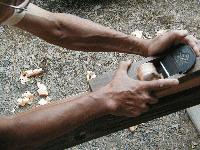 whilst Japanese pull the tools toward them (much more intuitive, i think). In Tora Dojo, our sensei very often emphasises the importance of the returning hand during a punch. Often, we do motion studies just to focus on the returning hand. Anther theme that is constantly stressed is the gathering up of energy from the ground and inwards before release. In Japanese woodworking,
whilst Japanese pull the tools toward them (much more intuitive, i think). In Tora Dojo, our sensei very often emphasises the importance of the returning hand during a punch. Often, we do motion studies just to focus on the returning hand. Anther theme that is constantly stressed is the gathering up of energy from the ground and inwards before release. In Japanese woodworking,  pulling the kanna, or hand plane, is an act that reflects this motion, engaging the woodworker's body in rhythmic movement and stances similar to those in karate. The attention to a centre of gravity and from 'rooting' one's actions in the earth is further paralleled in the position of the woodworker, who typically sits on the ground, sometimes even atop the work piece.
pulling the kanna, or hand plane, is an act that reflects this motion, engaging the woodworker's body in rhythmic movement and stances similar to those in karate. The attention to a centre of gravity and from 'rooting' one's actions in the earth is further paralleled in the position of the woodworker, who typically sits on the ground, sometimes even atop the work piece. The connection between martial arts and woodworking is the underlying metaphor of Miyamoto Musashi's seminal A Book of Five Rings, in which the way of the warrior is compared to the way of the carpenter.
The connection between martial arts and woodworking is the underlying metaphor of Miyamoto Musashi's seminal A Book of Five Rings, in which the way of the warrior is compared to the way of the carpenter. - Do not think dishonestly.
- The Way is in training.
- Become acquainted with every art.
- Know the Ways of all professions.
- Distinguish between gain and loss in worldly matters.
- Develop intuitive judgement and understanding for everything.
- Perceive those things which cannot be seen.
- Pay attention even to trifles.
- Do nothing which is of no use.
Fourthly the Way of the artisan. The Way of the carpenter is to become proficient in the use of his tools, first to lay his plans with a true measure and then perform his work according to plan. Thus he passes through life. These are the four Ways of the gentleman, the farmer, the artisan and the merchant.Comparing the Way of the carpenter to strategy
The comparison with carpentry is through the connection with houses. Houses of the nobility, houses of warriors, the Four houses, ruin of houses, thriving of houses, the style of the house, the tradition of the house, and the name of the house. The carpenter uses a master plan of the building, and the Way of strategy is similar in that there is a plan of campaign. If you want to learn the craft of war, ponder over this book. The teacher is as a needle, the disciple is as thread. You must practice constantly.
Like the foreman carpenter, the commander must know natural rules, and the rules of the country, and the rules of houses. This is the Way of the foreman.
The foreman carpenter must know the architectural theory of towers and temples, and the plans of palaces, and must employ men to raise up houses. The Way of the foreman carpenter is the same as the Way of the commander of a warrior house.
In the contruction of houses, choice of woods is made. Straight un-knotted timber of good appearance is used for the revealed pillars, straight timber with small defects is used for the innter pillars. Timber of the finest appearance, even if a little weak, is used for the thresholds, lintels, doors, and sliding doors, and so on. Good strong timber, though it be gnarled and knotted, can always be used discreetly in construction. Timber which is weak or knotted throughout should be used as scaffolding, and later for firewood. The foreman carpenter allots his men work according to their ability. Floor layers, makers of sliding doors, thresholds and lintels, ceilings and so on. Those of poor ability lay the floor joist, and those of lesser ability carve wedges and do such miscellaneous work. If the foreman knows and deploys his men well the finished work will be good.
The foreman should take into account the abilities and limitations of his men, circulating among them and asking nothing unreasonable. He should know their morale and spirit, and encourage them when necessary. This is the same as the principle of strategy.
The Way of Strategy
Like a trooper, the carpenter sharpens his own tools. He carries his equipment in his tool box, and works under the direction of his foreman. He makes culumns and girders with an axe, shapes floorboards and shelves with a plane, cuts fine openwork and carvings accurately, giving as excellent a finish as his skill will allow. This is the craft of carpenters. When the carpenter becomes skilled and understands measures he can become a foreman.
The carpenter's attainment is, having tools which will cut well, to make small shrines, writing shelves, tables, paper lanterns, chopping boards and pot-lids. These are the specialities of the carpenter. Things are similar for the trooper. You ought to think deeply about this.
The attainment of the carpenter is that his work is not warped, that the joints are not misaligned, and that the work is truly planed so that it meets well and is not merely finished in sections. This is essential.
If you want to learn this Way, deeply consider the things written in this book one at a time. You must do sufficient research.
Get your access to 16,000 woodworking sketches.
ReplyDeleteTeds Woodworking has over 16,000 woodworking plans with STEP BY STEP instructions, pics and blueprints to make all projects simple and easy...